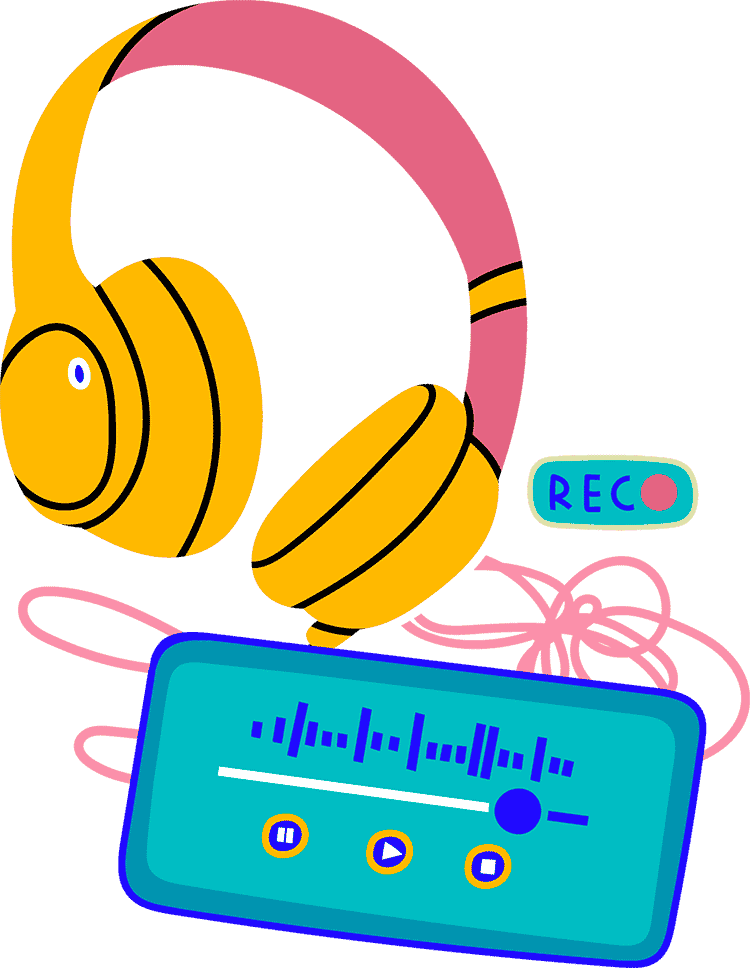I’m Jen Moss — Chief Creative Officer at JAR Audio, trained at the CBC in audio documentary storytelling, and a lecturer in Creative Writing at the University of British Columbia. My dual roles in the studio and the classroom have shown me that audio‑first doesn’t mean visually flat — it means crafting immersive scenes that invite listeners to see, feel, and inhabit every moment in a story.
At JAR Podcast Solutions, we believe that great audio podcasting is like mental cinema — rich, immersive storytelling that your listeners can see, feel, and walk through in their minds. We start by working with the smallest dramatic unit — each beat of conversation. From there, we use sound and dialogue to build self‑contained sonic scenes (each with their own beginning, middle, and end). When strung together, these scenes form a compelling episode‑length acoustic journey. From the very first second, we’re thinking of sound as:
- Architecture (location): Ambient beds and punctuated sounds that instantly place your audience in a vivid setting. Sound inside a cavernous room has a different quality from sound in a broom closet. The presence of wind, lab hums, ocean swells, city traffic… each of these things can help set the scene for the listener — without you even having to say a word.
- Character: Sound can accompany the different characters or guests on your podcast in a recurring sonic motif — like the delicate string of a violin, or a sub‑bass pulse — that becomes a familiar presence throughout, and help the audience keep track of the various personalities in your story.
- Punctuation: Micro‑pauses and stingers that act as audio commas, periods, question marks, and exclamations — guiding focus and shaping the rhythm of your story, driving home key points by emphasizing them sonically.
- Transition: Gentle crossfades, stings, or signature drones can help bridge from one scene to the next, drawing the listener’s attention through the story, and / or giving listeners a moment to absorb what they’ve just heard. Alternatively – key sounds might cue the listener that the action has moved – travelled to a new setting, or a different moment in time.
- Essence: Textures and effects that capture the mood of an individual character or scene, or the spirit of a process, so you don’t just hear the story — you feel its pulse.
Below, I’ll walk you through a couple of examples that show how each of these sonic roles combines with narrative flow and strategic silence to turn “audio‑first” podcasts into unforgettable mental journeys.
1. Constructing scenes in audio podcasting
Audio scenes consist of a series of beats. If you’d like to check out a real‑world example, go have a listen to the very opening scene of Genome BC’s Nice Genes! S2, Ep. 3, “Calls from the Deep,”. The episode opens with a scientist’s field recordings aboard a boat on the way to Finn Island, a whale observation station. You can hear deck creaks and gull calls — before a single word is spoken, dropping you straight into an active maritime audio diorama.
- Beat 1 – Setup (Beginning): Establishes context with location cues, like wind and waves, or a boat launching into water.
- A scientist introduces Finn Island station as she launches her boat, and calls the station on her ship-to-shore radio.
- Beat 2 – Complication (Middle): Layer interviews, data, and ambient textures to heighten tension.
- The role of the whale observation station is explained.
- Beat 3 – Payoff (End): Resolve with insight or a defining sonic cue that naturally leads to the next scene.
- We hear some examples of the whale songs they are recording, live from the boat. We get an immersive sense of subdued excitement – the feeling of “being there” as the sounds are coming in.
- We hear some examples of the whale songs they are recording, live from the boat. We get an immersive sense of subdued excitement – the feeling of “being there” as the sounds are coming in.
2. Designing flow like a cinematographer
Just as a filmmaker chooses cuts and match‑cuts to guide the eye, we sculpt audio flow:
- Sound as punctuation:
- Sharp silences before big reveals act like exclamation points.
- Quick stingers after key lines provide closure.
- Sharp silences before big reveals act like exclamation points.
- Sound as transition:
- A filtered bass drone or ambient swell eases listeners from one scene to the next.
- Crossfades give a beat to process what’s just happened before a new setting unfolds.
- A filtered bass drone or ambient swell eases listeners from one scene to the next.
Real-world example
In Sound Matters Episode 16, “The Bass, The Colour, The Mystery of Synesthesia” (a SONOS podcast), synesthesia — when one sense automatically evokes another — takes center stage. Around the four‑minute mark, the mix nearly falls silent, leaving only a subdued tension track as a synesthete quietly reflects, “Wednesday’s blue,” giving listeners a moment to see that hue in their minds. Without a word of narration, the tension track then dissolves into the wind and gentle lapping of Jamaican waves, signaling a shift to the next scene. Later, the audio moves again — this time into the hollow echoes of a stone church — its cool, cavernous reverb underscoring an expert’s insight that sound often stirs emotion and imagery even more powerfully than sight.
3. Using silence like negative space
With audio storytelling, leaving space around the various assertions and beats of your story is more important than with visual stories. The audience has no visual aids, so you need to allow silences and spaces for their brains to catch up, and fully process what they’ve just heard. So silence isn’t empty airtime — it’s the negative space that makes every sound pop:
- Scene breaks: Full‑second pauses between scenes let listeners digest revelations.
- Beat punctuation: Half‑second gaps before a punchline amplify its impact.
Real‑world example
After host Kaylee Byers makes one of her frequent eye-rolling puns on Nice Genes, the creative team always leaves just the shade of an extra-long pause – for the pun to hit, and for the audience to groan inwardly before moving on. So whether it’s a whale-call “orca-stra” or a “tails up” that changes are afoot in the world of whales – the audience is given a second to bask in the glory of the pun before the story moves on.
4. Painting with sound
By weaving together our five core sound roles — location, architecture, character, punctuation, transition, plus the essence of a process — we transform episodes into fully realized worlds. Each role plays off the others:
- Architectural layers (lab hums, sea ambience) set the stage.
- Character motifs (whale‑song stingers, sub‑bass pulses) anchor emotional beats.
- Punctuation and transitions shape pacing and scene-to‑scene flow.
- Strategic silence gives the audience time to breathe and imagine.
- Textural essence immerses you in the heart of the story.
Real-world example
A beautiful real-world example of these approaches occurs in the aforementioned Nice Genes Episode about whales, when the host introduces the various sounds of different whales around the globe as instruments in an underwater “symphony of sound.” We hear the tuning of an “orca-stra”(insert pause), with the violins being the high-pitched orcas, the sperm whales being the cellos, humpbacks are woodwinds, fin whales are brass instruments – and the great blue whale a percussion section. As the various sonic motifs mix together, we are treated to a beautiful, immersive underwater soundscape that helps us imagine the diversity of whale calls beneath the surface.
Conclusion
“Audio‑first” isn’t simply code for a smaller-budget podcasts. While it’s true that audio-first podcasts do tend to be cheaper, overall, than “video-first” shows, this is not why our clients love them. At JAR, audio-first podcasts are creatively empowering. They’re a chance for our writers and editors to lean more fully into the potential of audio storytelling. For our clients to give an immersive and captivating gift to their audience. The extended listen-through rates of immersive, narrative-style audio podcasts are proof that audio podcasting can be as visually and emotionally arresting as any film. At JAR, we build that mental cinema effect one beat, one scene, one pause, and one carefully crafted sound at a time.

Jen Moss is the Co-Founder and and Chief Creative Officer of JAR Audio. As JAR’s podcast “doula”, collaborating with enterprise brands to bring great podcasts into the world. With a background spanning CBC Radio, Canada’s National Film Board Digital Studio, Vancouver’s Roundhouse Radio and the University of British Columbia, she guides the creation of captivating podcasts at JAR.



